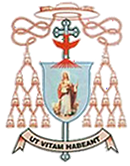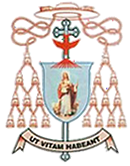By
Most Rev. Valerian M. Okeke
(Metropolitan Archbishop of Onitsha)
Given at Blessed Iwene Tansi Major Seminary, Onitsha
21-10-2023
 21.10.2023
21.10.2023
DEDICATION OF THE CHAPEL OF BLESSED IWENE TANSI MAJOR SEMINARY, ONITSHA
1. SOME CLARIFICATIONS:
v Church:
From ancient times, the name Church has also been given to the building in which the Christian community gathers to hear the word of God, to pray together, to celebrate the sacraments and to participate in the Holy Eucharist. Initially Church – “Ecclesia” means the people of God.
v Chapel: what is it?
It is a miniature Church, originally established as a place of prayer or oratorium in royal or episcopal residences. With the extension of Christianity to rural areas, the chapel gradually gained a public function as it was also erected for local population and institutions.
v Dedication of a Church:
Dedication is more than an ordinary blessing. It is a consecration, a spiritual transformation which changes the essence or the intrinsic meaning of a thing.
v The Minister:
The minister of dedication is the Bishop, the Local Ordinary in the case of diocesan Churches or the Metropolitan Archbishop in the case of provincial institutions or the President of Bishops in the case of national institutions. The Bishop can also delegate another Bishop.
It is the duty of the Local Ordinary to dedicate all the new Churches built in his diocese. If for some reasons it is not possible, he should delegate another Bishop.
v The Day of Dedication:
This should be done on a day when many more people i.e., the faithful could be present, preferably on a Sunday or Octave.
v Invocation of the Saints:
After the homily and the profession of faith, the general intercession is omitted but the litany of the saints is sung.
The litany of the saints as a prayer, is an act of faith and humility calling on all the saints in heaven to intercede for us, to invite God to accept, take possession of and occupy this special building.
v Anointing of the Altar:
This makes the Altar a symbol of Christ, who is and is called the anointed one because the Father anointed him with the Holy Spirit and constituted him the High Priest so that on the altar of his body, he might offer the sacrifice of his life for the salvation of the world.
v Burning of Incense on the Altar:
This is to signify that Christ sacrifice there at the altar, perpetuated in mystery ascends to God as an odor of sweetness and also the people’s prayers rise up pleasing and acceptable to God.

v Incensation of the People:
This is because the people of God are the living temple in which each faithful member is a living altar. That is why the people of God are incensed first.
v The Lightning of the Candles:
This indicates that Christ is the light of the world. The light which enlightens all nations. His brightness shines through the Church to the entire world – the human family.
v The idea of Dedicating a Temple to the Lord:
The first dedication of the temple we read in the scriptures is that of King Solomon (1st Kings 8:22ff).
We recall that David wanted to build but the Lord said no…. and the privilege was given to Solomon. (Today, it is still a privilege).
Remember the Lord said to Solomon, “If you obey my laws and commands, I will do for you what I promised your father David. I will live among my people Israel in this Temple that you are building, and I will never abandon them” (1st Kings 6: 11-14).
When Solomon finished, he prayed, ……O God, watch over this temple day and night, this place where you have chosen to be worshipped. Hear me when I come into this temple and pray. Hear my prayer and the prayers of your people when they come into this place. From your home in heaven hear us and forgive us. (1st Kings 8:28-30ff)
2. INDIVIDUAL ROLE
 As each Church is dedicated, each Christian present is dedicated a new, renewed and called upon to ongoing renewal and reform.
As each Church is dedicated, each Christian present is dedicated a new, renewed and called upon to ongoing renewal and reform.
The dedication of the Temple is an annual event, an annual feast in Israel. Its origin is traced to the time of the Macabees. The feast is called HANUKKAH (1st Macabees 4:36-59).
On the 25th year of the reign of Antiochus Epiphanes IV, the Syrian monarch, he desecrated the temple by sacrificing to Zeus at the altar he erected at the Sanctuary.
Three years after, the revolutionary Judas Maccabeus led a revolution with success. After which he rededicated the temple in a joyous ceremony and decreed an annual observance of the feast.
In the Church today, the dedication of each Church is also observed as an annual feast.
In the book of Nehemiah, we read about the rebuilding of the temple and its rededication. Note that Nehemiah wanted not only a new Church but a new city and new people through renewal of the covenant.
Remember what St. Paul tells us. “The Temple of God is holy and that Temple is you”.
3. THE VALUE OF THE DEDICATED (CHURCH) TEMPLE
The prophet Ezekiel gives us a vision of a restored Temple. Out of the new Temple will flow a living water the river of God with miraculous effects on the land.
The Church through her sacraments has these values. Christ through his death and resurrection became the true and perfect Temple – of the new covenant. The people of God are part of this mystical body.
The temple of God has the living water, the sacraments.
 Come with faith and receive God’s blessings. However, do not forget on going purification. Do not desecrate the temple. The temple of God is holy and that temple is you.
Come with faith and receive God’s blessings. However, do not forget on going purification. Do not desecrate the temple. The temple of God is holy and that temple is you.
PRAYER:
May God give us the grace to always rededicate ourselves. May he take possession of this Church dedicated to him (take possession of ourselves) and may he always listen with favor when ever we call upon him.
May he forgive us when we err and shield us from all harm – Through Christ our Lord. Amen.
Most Rev. Valerian Maduka Okeke
Metropolitan Archbishop of Onitsha
Given at Blessed Iwene Tansi Major Seminary, Onitsha
21-10-2023

